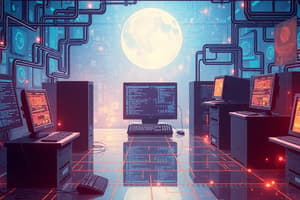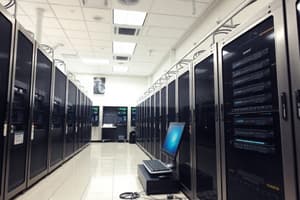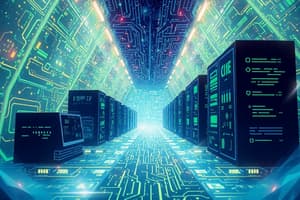Podcast
Questions and Answers
What is one of the main characteristics of computers?
What is one of the main characteristics of computers?
- Limited storage capacity
- Inaccuracy
- Complexity in design
- High speed (correct)
The word 'computer' is derived from the word 'compute.'
The word 'computer' is derived from the word 'compute.'
True (A)
What is the purpose of processing data in a computer?
What is the purpose of processing data in a computer?
To convert data into information.
A computer accepts, sorts, selects, moves, and compares various types of ______.
A computer accepts, sorts, selects, moves, and compares various types of ______.
Match the following terms with their definitions:
Match the following terms with their definitions:
What is the first part of the information processing cycle?
What is the first part of the information processing cycle?
Output is a mandatory step in the information processing cycle.
Output is a mandatory step in the information processing cycle.
What term is used to describe the set of instructions given to a computer to perform various operations?
What term is used to describe the set of instructions given to a computer to perform various operations?
The physical parts or devices of a computer system are referred to as _____
The physical parts or devices of a computer system are referred to as _____
Match the following components of the information processing cycle with their correct definitions:
Match the following components of the information processing cycle with their correct definitions:
Flashcards
Computer
Computer
A device that processes data to create useful information, originally designed as a fast calculator for complex calculations.
Data
Data
Raw, unorganized facts and figures.
Information
Information
Data that has been processed, organized, and presented in a useful context to answer questions or solve problems.
Information Processing Cycle
Information Processing Cycle
Signup and view all the flashcards
Computer System
Computer System
Signup and view all the flashcards
Input
Input
Signup and view all the flashcards
Processing
Processing
Signup and view all the flashcards
Output
Output
Signup and view all the flashcards
Storage
Storage
Signup and view all the flashcards
Information Processing Cycle
Information Processing Cycle
Signup and view all the flashcards
Computer Program
Computer Program
Signup and view all the flashcards
Data Processing
Data Processing
Signup and view all the flashcards
Hardware
Hardware
Signup and view all the flashcards
Software
Software
Signup and view all the flashcards
Study Notes
Chapter 1: Introduction to Computer Systems
- Objectives:
- Learn the concept of a computer system.
- Understand how computers have evolved.
- Understand computer classifications.
- Learn about computer applications.
- Understand computer characteristics (speed, accuracy, efficiency, storage capacity, versatility).
- Understand computer limitations.
- Discuss similarities and differences between humans and computers.
- Understand computer components.
1.1 Introduction - Computer
- The word "computer" comes from the word "compute".
- Originally, a computer was a fast calculator.
- Today, computers perform various tasks beyond basic calculations.
1.2 Computer As Data Processor
- Data: Unorganized, raw facts needing processing.
- Information: Processed, organized data presented usefully.
- Data is transformed into Information.
1.2.2 The Information Processing Cycle
- Input: Data received from sources.
- Processing: Computer actions on data based on instructions.
- Output: Results presented (text, numbers, graphics, sound).
- Storage: Permanent storage of results. (Disk, tape).
1.2.3 Computer As Data Processor
- Computer program: Instructions guiding operations.
- Data Processing: Converting input data to output.
- Computers process information rapidly by following instructions.
1.3 Classification of Computers
- Analog Computers:
- Recognize data as continuous measurements (voltage, speed).
- Output in form of dials, graphs.
- Digital Computers:
- Use discrete signals (high/low voltage states: 1's and 0's).
- Numbers, alphabets, symbols represented as code.
- Classifications based on size/capacity:
- Small Computers (Microcomputers, PCs) - basic/everyday use.
- Note Book/Laptops - portable use
- Handheld - smaller-portable
- Mini computers - more powerful than microcomputers. Wide use in process control
- Mainframe computers - high speed; large organizations
- Super computers - fastest; complex tasks; parallel processing
1.3 Hybrid Computers
- Combine analog and digital features.
- Useful when input is analog (measurements). Converted to digital for processing.
- Input from sensors, conventional output methods.
Hardware and Software
-
Hardware: Physical components (integrated circuits, storage, input/output devices).
-
Software: Programs, procedures, and documentation. (Used to control operation of hardware)
-
Computer hardware can’t function on its own without software instructions.
Studying That Suits You
Use AI to generate personalized quizzes and flashcards to suit your learning preferences.




